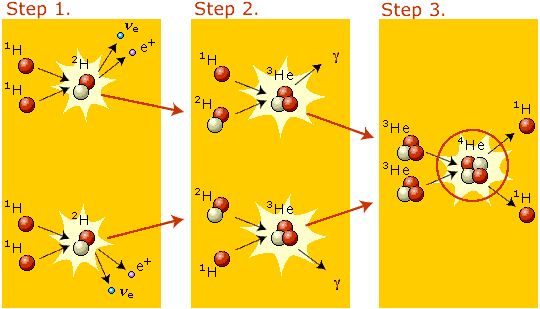|
Fusion Powers the Sun and Other StarsGravitational Energy?In the 19th century the sun and other stars were assumed to be powered by gravitational energy: matter falling into the sun would release energy, as would contraction of the sun. However, calculations showed that the lifetime of the sun would be only about 30 million years, much shorter than estimates of the age of the earth (now estimated at 4.6 billion years!). Gravitational energy must be ruled out! However, gravitation plays an important role for later stages of a star's life. Fusion Powers the SunThe gas in our sun (hydrogen and helium nuclei) and in other stars is hot enough to produce collisions where fusion can take place. In the centre of the sun the temperature is about 15 million degrees centigrade and it is even hotter in other stars. Protons (hydrogen nuclei) are making fusion reactions and produce helium according to the proton-proton cycle or to the carbon cycle, proposed by Hans Bethe in 1939. Bethe received the 1967 Nobel Prize in Physics.
|
 |
 |
The Supernova Explosion |
||
|
When the hydrogen in a star is exhausted, the star contracts due to gravitation. The temperature increases, and helium can start to fuse. This process continues until iron is formed. If the mass is large enough the gravitation is so strong that the star collapses and becomes a neutron star (all protons being transformed into neutrons) or a black hole. This explosion is called a supernova. Subrahmanyan Chandrasekhar and William A. Fowler received the 1983 Nobel Prize in Physics for their works on the evolution of stars and formation of the elements in the universe.
|
|
The Energy Source of Tomorrow? |
||
|
The fusion of light nuclei can give more energy per kg material than fission. The energy produced by fusion of one litre of deuterium corresponds to the energy produced by combustion of 600 litres of gasoline. A particularly attractive possibility is to use heavy hydrogen, deuterium, which is available in sea water. In the world's oceans there is 1015 kg of deuterium available! Much research today is devoted to make temperatures sufficiently high for a fusion reactor to work. |
|
|